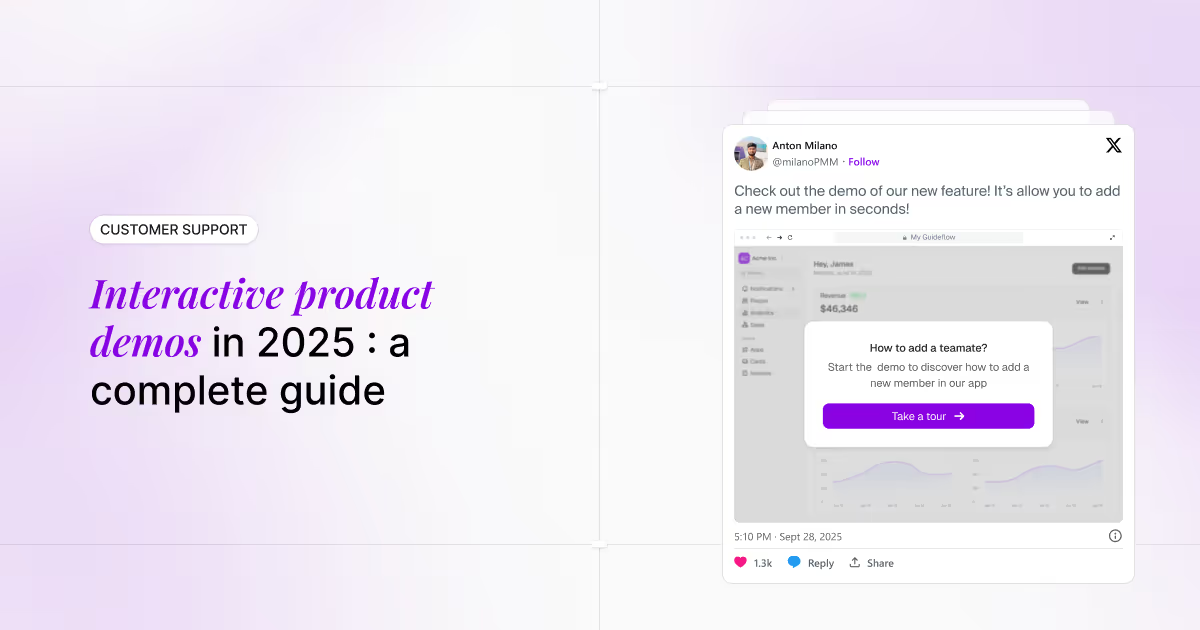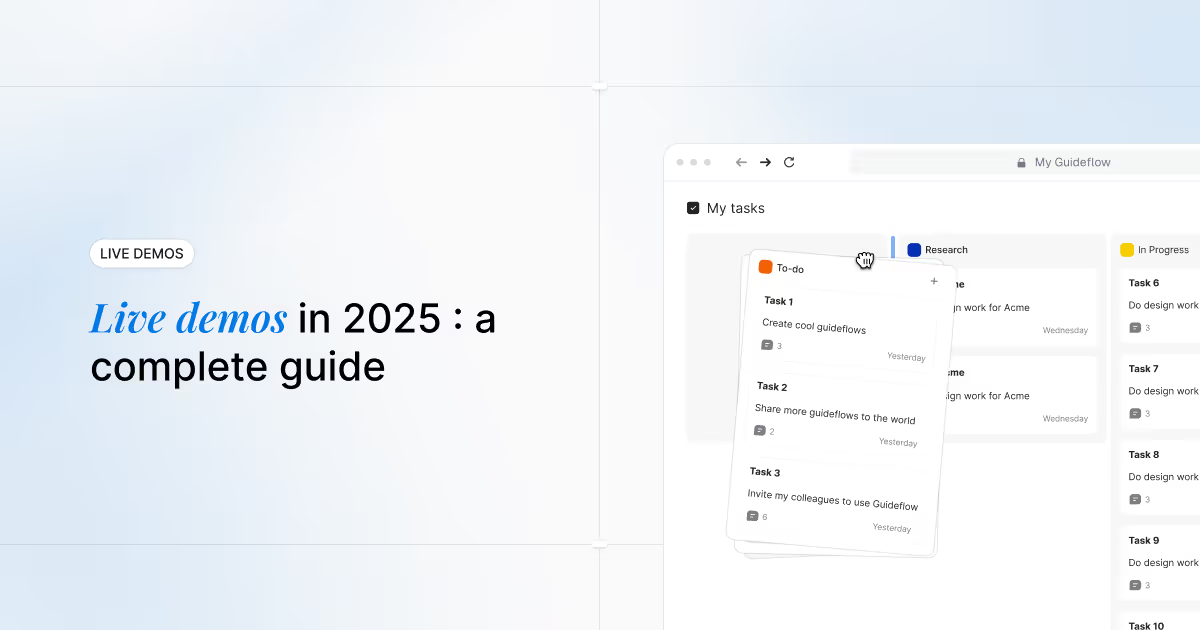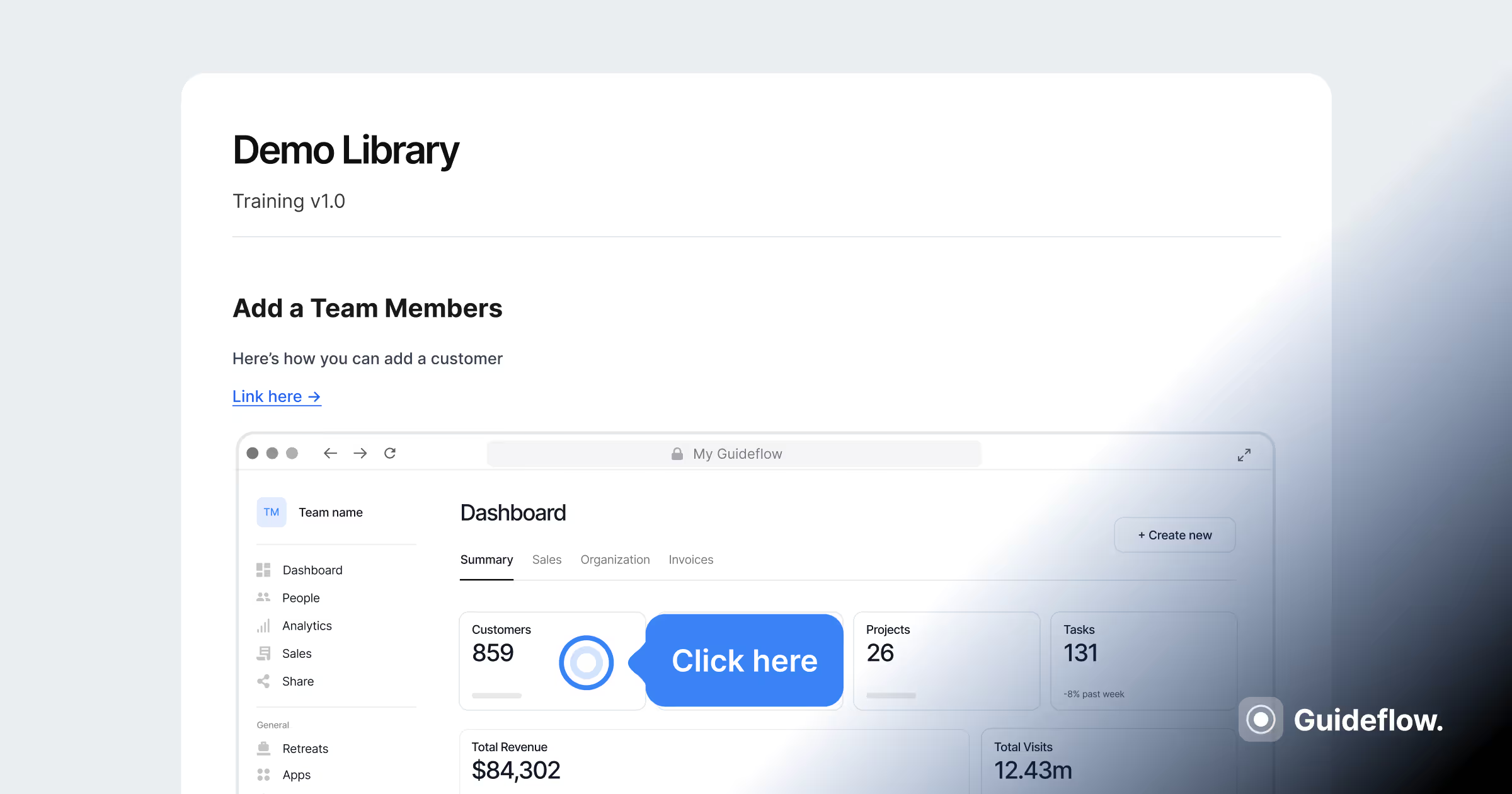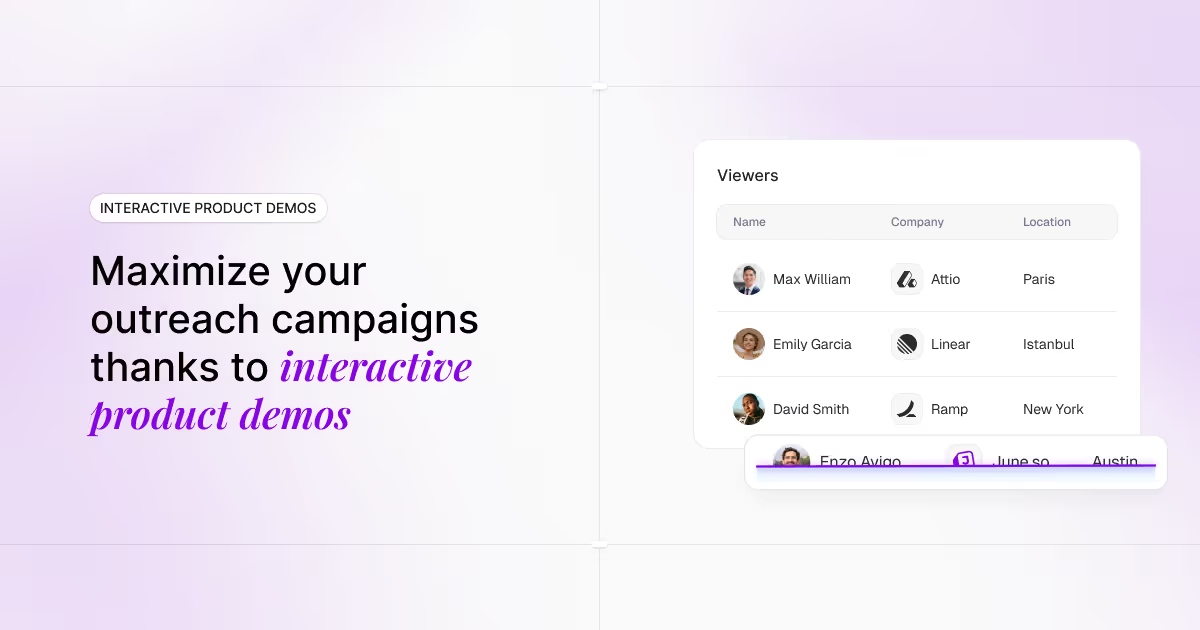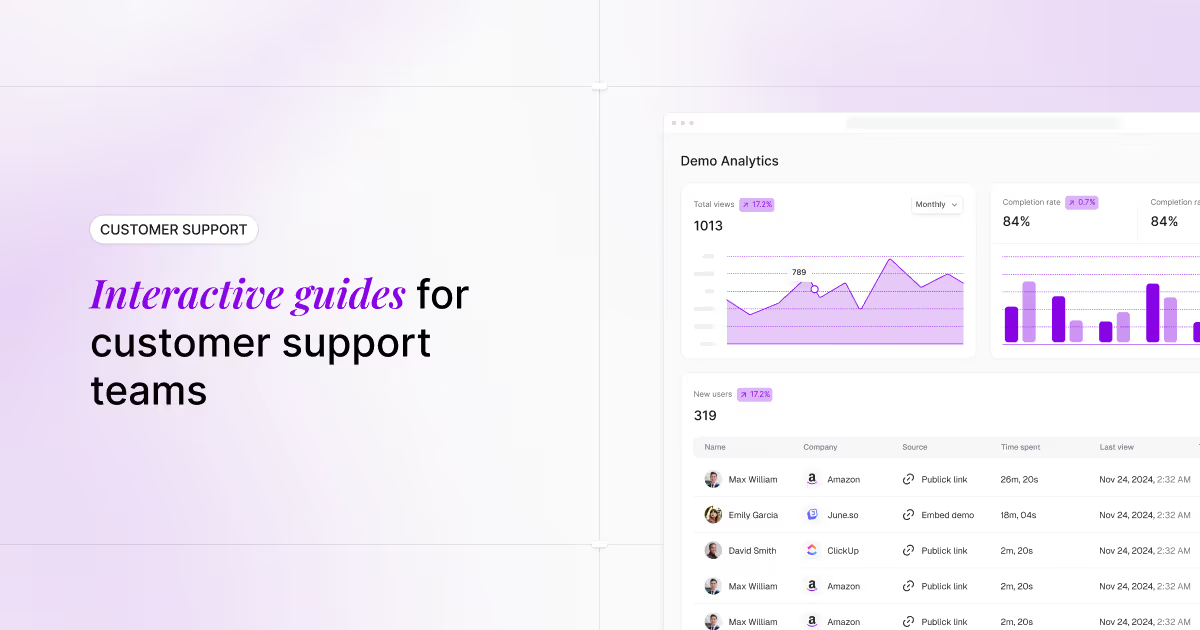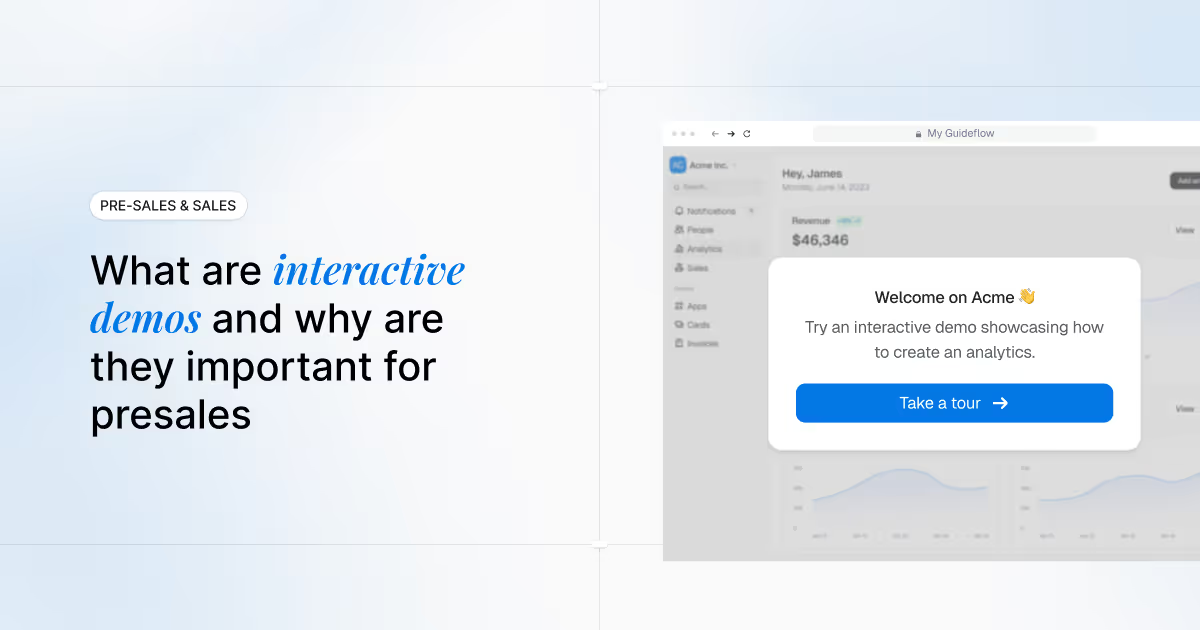Product managers connect customers, engineering, and go-to-market teams. In 2025, their role is more dynamic and demanding than ever. User expectations are rising, feature launches are demanding, and feedback loops are often too slow to drive real-time improvements. Today, showing is better than telling. Product managers need to validate, educate, and drive adoption with less friction and more insight, which is where interactive demos come in.
Try it now: create your first product launch demo with Guideflow
TL;DR: Why this guide matters
Product teams use interactive demos to validate features before committing engineering resources, bridge communication gaps with GTM and support teams, and accelerate user adoption through contextual learning experiences. This guide demonstrates how demos transform abstract product concepts into tangible artifacts that drive alignment, shorten feedback cycles, and create measurable pathways from initial curiosity to sustained engagement. You'll learn to leverage demos as both validation instruments and enablement tools that reduce time-to-value across your entire product lifecycle.
The challenge of product management
PMs are expected to act as mini-CEOs, owning the roadmap, aligning teams, and delivering results. But they face real constraints: feature launches often see low engagement, internal stakeholders lack context about product decisions, there's poor visibility into how new features are actually used, and it's difficult to scale enablement for sales, support, or onboarding.
Interactive demos help PMs reduce time-to-feedback, make launches stickier, and communicate roadmap value in a more compelling, scalable way.
What are interactive demos for product managers?
Interactive demos are guided, click-through simulations that recreate your product's real workflows in a lightweight environment - no code, credentials, or full builds required. Product managers rely on them to align vision, accelerate decisions, and drive adoption throughout the product lifecycle.
Rather than static mockups or slide decks, interactive demos let PMs validate product concepts before a single line of code ships. Stakeholders and users provide feedback on simulated flows, catching friction early. They communicate complex features with clarity - Engineering sees the interaction model, Design reviews the intended experience, Sales understands the value story, and Marketing crafts launch messaging from a shared artifact.
Demos support cross-functional alignment during planning and handoffs, eliminating ambiguity when requirements move between teams. They enable self-serve onboarding by letting users explore features at their own pace, reducing Support tickets and freeing Product teams from repetitive walkthroughs. Embedded in release notes, changelogs, and help docs, they drive adoption and engagement by meeting users exactly where they need guidance.
From internal planning docs and kickoff meetings to external product launches and customer education, interactive demos serve as a shared language. They help PMs build clarity, rally alignment, and accelerate value delivery - without waiting on production environments.
Why use interactive demos in product management?
Validate features with real users before launch
Interactive demos enable product managers to test prototypes and simulations with target users during early development stages. This approach surfaces usability issues, feature gaps, and user preferences before engineering resources are committed to full implementation. By gathering qualitative feedback on workflows and quantitative data on user interactions, teams can iterate on designs with confidence. This validation process reduces the risk of building features that miss the mark and helps prioritize development efforts based on actual user behavior rather than assumptions.
Accelerate internal enablement
Product managers face the recurring challenge of keeping cross-functional teams aligned on new capabilities. Interactive demos solve this by providing sales, customer success, and support teams with hands-on experience before features reach production. Rather than waiting for staging environments or relying on slide decks, these teams can explore functionality themselves, ask informed questions, and develop accurate mental models. This self-service approach can reduce training time by up to 40% while ensuring consistent messaging across customer-facing teams.
Improve feature discoverability
Even well-designed features go unused if users don't know they exist. Interactive demos embedded directly into product documentation, in-app tooltips, or release announcements guide users through new functionality at the moment of need. This contextual approach transforms passive documentation into active learning experiences. Users can explore capabilities at their own pace, building confidence through direct interaction rather than reading static instructions. The result is faster feature adoption and reduced support burden.
Close the feedback loop
Product managers need concrete data to understand how users engage with features. Interactive demos generate behavioral analytics showing where users click, which paths they follow, and where they abandon flows. This data reveals friction points that might not surface in user interviews or surveys. By tracking engagement patterns across different user segments, product managers can identify which features resonate, which need refinement, and where to focus optimization efforts. These insights inform roadmap decisions with evidence rather than intuition.
Turn launches into adoption
Shipping a feature is only the beginning. Interactive demos bridge the gap between launch and meaningful usage by serving as embedded training for each release. Instead of expecting users to figure out new capabilities independently, demos provide structured walkthroughs that reduce time to value. This approach is particularly effective for complex workflows or features that represent significant changes to existing patterns. By lowering the learning curve, product managers can increase customer satisfaction and demonstrate product value more quickly.
Bridge the gap between product and GTM teams
Interactive demos create a shared reference point between product managers and go-to-market teams. Marketing can use demos in campaigns to generate interest and drive conversions, while product managers maintain control over how features are presented. This alignment ensures that marketing promises match product reality, reducing friction between teams and creating more accurate customer expectations.
Reduce time to value for new customers
The onboarding section mentions that interactive demos help customers quickly learn how to use the product and its features, reducing time to value and increasing customer satisfaction. Product managers can use demos to identify and eliminate onboarding bottlenecks, ensuring new users reach their "aha moment" faster. This directly impacts activation rates and early-stage retention.
Scale product expertise across the organization
As mentioned in the alternatives section, interactive demos can reduce the load on customer support teams by helping customers solve their own problems. This allows product managers to scale their product knowledge without being a bottleneck, empowering every team member to demonstrate features accurately and confidently.
Create a living product specification
Unlike static documentation that quickly becomes outdated, interactive demos can be quickly and easily updated with new features or functionality. This makes them a dynamic reference that stays current with the actual product, serving as both user-facing documentation and internal specification that evolves alongside development
Where and when to use interactive demos in product management
- Pre-launch validation: share demonstrations of planned features to test assumptions and gather early feedback from design partners or beta testers.
- In feature announcements, pair demos with launch emails or in-app messages to enhance engagement.
- During GTM enablement, embed demos in internal wikis, Notion docs, or training hubs to educate sales, customer success, and support teams.
- In the knowledge base or help center, include interactive walkthroughs demonstrating how users can complete key tasks.
- In customer feedback loops, use demos to visualize feature concepts during roadmap discussions.
Real product management use cases
Use case 1: Validate feature ideas before you build

Challenge
Product managers face a recurring dilemma: how to validate feature ideas with stakeholders and users before allocating design or engineering resources. Static mockups lack interactivity and fail to communicate how a feature actually works. Discovery interviews rely on hypothetical scenarios rather than hands-on experience. Prototypes built in code require significant investment before you know if the concept resonates. This creates a validation gap where teams either move forward on assumptions or spend weeks building throwaway code just to test an idea.
The cost of this gap is substantial. Teams waste sprints building features that miss user needs. Stakeholders approve concepts based on slides that don't reflect the actual user journey. By the time usability issues surface, you've already committed resources and face pressure to ship rather than iterate. Product managers need a way to test the experience without building the product.
Solution
Interactive demos provide a middle ground between static mockups and functional prototypes. Using no-code tools, product managers can simulate the intended user experience in hours rather than weeks. These demos are clickable, realistic representations of the proposed feature that stakeholders and users can interact with directly.
The process starts with your existing wireframes or design files. You build out the key screens and connect them with realistic interactions that mirror the intended user flow. The result is a demonstration that feels like a working product but requires no backend integration, no data structures, and no production-ready code.
Deploy these demos in stakeholder reviews to gather specific feedback on navigation patterns, information architecture, and value proposition. Use them in user research sessions to observe where participants hesitate, what they expect to happen next, and whether the feature solves their actual problem. Share them with cross-functional teams to build alignment on scope and functionality before design handoff. The interactive format reveals gaps and assumptions that remain hidden in static presentations.
Benefits
- Shortens the feedback loop from weeks to hours
- Helps prioritize features based on real user reactions
- Minimizes resource waste by identifying misaligned ideas early
- Aligns stakeholders around a tangible, shared vision
- Builds confidence and momentum before kicking off sprints
When to use
- During early-stage exploration or roadmap planning
- Before locking in wireframes or design specs
- To pitch new concepts to leadership, design, or GTM teams
- As a lightweight A/B alternative for internal feedback
- as a lightweight A/B alternative for internal feedback
Use case 2: Reproduce and share bugs more efficiently
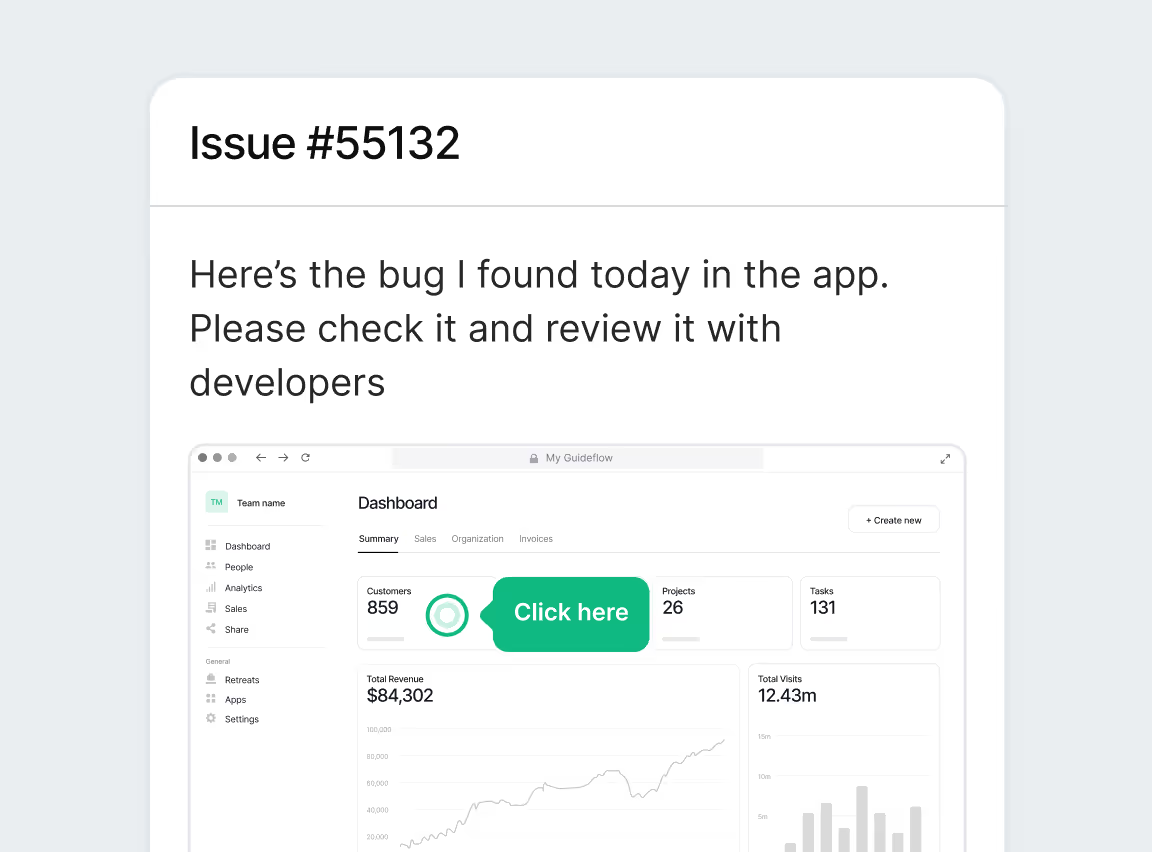
Challenge
Bug reports often arrive incomplete or ambiguous. Support tickets describe symptoms without context. QA reports list steps that engineers cannot reliably reproduce. Screenshots capture moments but not sequences. Screen recordings run long and require manual scrubbing to find the relevant interaction.
This ambiguity creates a costly cycle. Engineers spend hours attempting to recreate conditions based on incomplete information. They interrupt their workflow to ask clarifying questions. Support teams struggle to articulate what users experienced. QA teams write lengthy reproduction steps that still miss critical details about timing, state, or configuration. The back-and-forth drains velocity and delays fixes for issues that could be resolved quickly if understood correctly from the start.
The problem compounds when bugs surface in complex workflows involving multiple screens, conditional logic, or specific data states. A simple description like "the save button doesn't work" could represent dozens of different underlying issues depending on user permissions, form validation state, network conditions, or previous actions in the session. Without precise reproduction steps, engineering teams either spend excessive time investigating or deprioritize issues they cannot verify.
Solution
Interactive demos transform bug reporting from description to demonstration. Instead of writing paragraphs explaining what went wrong, teams create clickable reproductions that show exactly how the issue manifests. These demos capture the precise sequence of user actions, the state of the interface at each step, and the point where behavior deviates from expectations.
The process begins when a bug is identified. Rather than documenting steps in text, the reporter builds a quick interactive demo that mirrors the problematic flow. This includes the screens involved, the data entered, the buttons clicked, and the error or unexpected behavior encountered. The demo preserves context that written descriptions lose, such as which fields were populated in what order, whether certain UI elements were visible, and what the user expected to happen next.
Engineering teams receive these demos as direct links. They click through the exact reproduction path without needing to set up test data, navigate to the right screen, or interpret ambiguous instructions. The interactive format answers questions before they are asked. They see which form validation fired, which API call failed, or which conditional logic branch triggered the issue. This clarity accelerates diagnosis because engineers spend time solving problems rather than understanding them.
Support and QA teams use the same approach for escalation. When a customer reports an issue, support can build a demo showing the problem and share it directly with engineering. QA teams document regression tests as interactive demos that serve as both bug reports and verification tools. Product managers reviewing bug backlogs can click through each issue to understand severity and impact without requiring technical explanation.
Benefits
- Reduces friction between QA, support, and engineering by showing, not telling
- Accelerates diagnosis and resolution by removing ambiguity
- Enables faster prioritization of critical issues with concrete, replayable context
- Improves bug report quality and stakeholder trust
- Makes handoffs smoother and more efficient across sprint cycles
When to use
- When escalating support issues to engineering
- In QA regression testing or bug bounty programs
- During grooming sessions and sprint planning
- When aligning PMs, QA, and engineers on issue severity and scope
Use case 3: Launch features with clickable, guided walkthroughs

Challenge
Product managers invest significant effort building features that solve real user problems, yet many launches fail to generate the expected adoption. Users often miss announcements entirely, skim through release notes without internalizing the value, or feel hesitant to experiment with unfamiliar functionality in their live environment. Traditional launch tactics like email blasts, in-app tooltips, or static blog posts lack the depth needed to communicate both how a feature works and why it matters. This gap between launch and understanding creates friction in the adoption curve, leaving product teams with limited feedback, low engagement metrics, and uncertainty about whether the feature itself needs refinement or if the issue lies in how it was introduced.
Solution
Interactive demos transform feature launches from one-way announcements into exploratory learning experiences. Product managers can build guided, self-serve walkthroughs that allow users to click through real workflows, see the feature in context, and understand its value proposition without needing to configure anything or risk breaking their setup. These demos can be embedded directly into changelogs, in-app messages, onboarding sequences, help center articles, and internal enablement materials. Users engage with a realistic simulation of the feature, progressing through key actions and decision points at their own pace. This hands-on format bridges the gap between reading about a feature and actually using it, creating confidence before users ever interact with the live product.
Benefits
- Converts passive communication into experiential learning, helping users internalize not just what changed but how to apply it
- Shortens the path to value by guiding users directly to the moments where the feature solves their problem
- Lowers activation friction by removing the intimidation factor associated with trying something new in a production environment
- Aligns cross-functional teams around a shared understanding of the feature, enabling Sales to demonstrate capabilities during demos, Customer Success to reference walkthroughs during support conversations, and Marketing to embed them in campaigns
- Provides product managers with early behavioral signals about which parts of the feature resonate, where users drop off, and what questions arise most frequently, all before adoption data becomes available in analytics platforms
- Reduces the burden on support and success teams by preemptively answering common questions through interactive guidance
When to use
- On launch day, to maximize visibility and engagement when excitement is highest
- Within onboarding flows to introduce new users to capabilities they might otherwise overlook
- Inside changelogs, knowledge bases, and release emails to provide context that static text cannot convey
- As a training resource for internal teams who need to quickly understand and communicate the feature's purpose and mechanics
- In targeted campaigns to re-engage existing users who have not yet explored the new functionality
Interactive demos provide the clarity and confidence users need to move from awareness to action, while giving product teams the feedback and alignment necessary to refine both the product and the go-to-market strategy.
Use case 4: Enable internal teams without waiting on dev
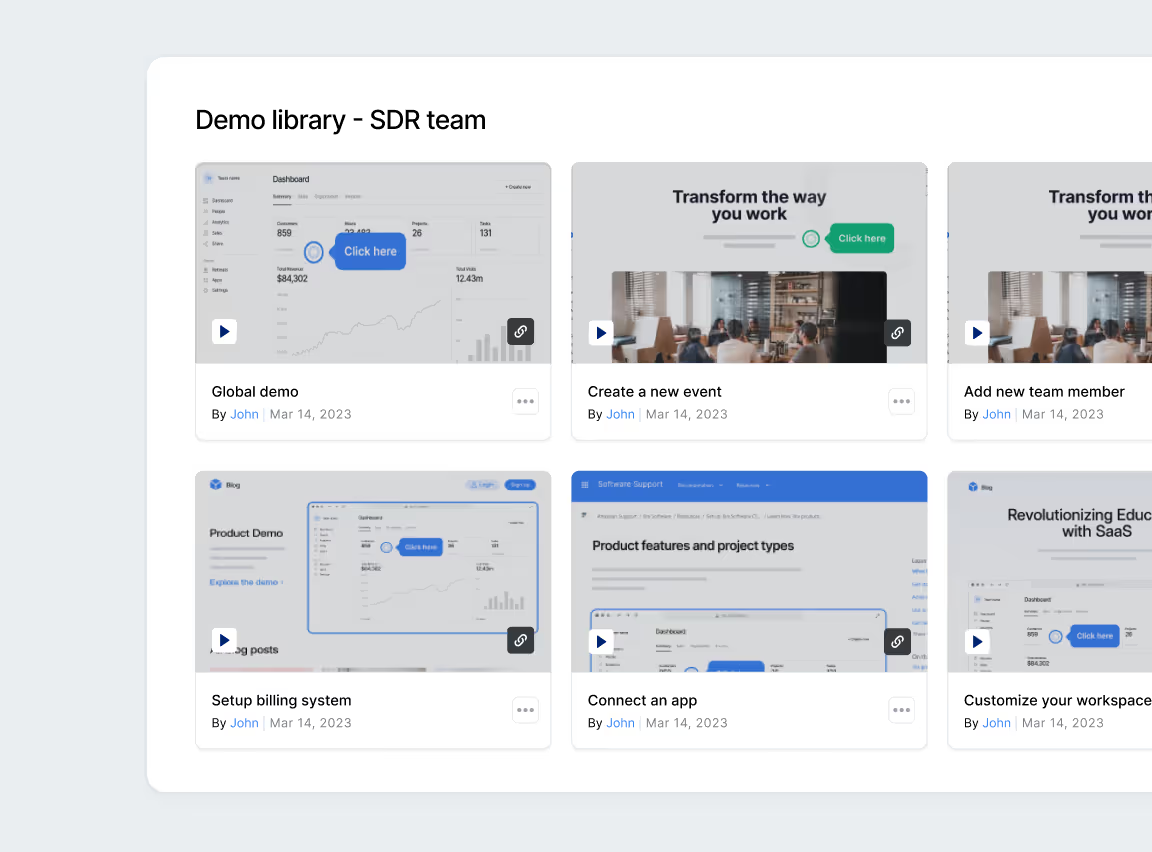
Challenge
Product managers often face a familiar bottleneck: new features are ready to ship, but Sales, Support, and Customer Success teams remain in the dark until the last moment. The delay stems from practical constraints like unavailable staging environments, incomplete documentation, or features still being finalized. Meanwhile, these teams need to craft messaging, prepare demos, and answer customer questions. The gap creates real friction: inconsistent narratives reach the market, adoption slows, and early opportunities for revenue or retention slip away. For product managers juggling roadmaps and stakeholder alignment, this creates yet another coordination burden that eats into strategic work.
Solution
Interactive demos offer a way to break this cycle. By creating a self-contained, explorable version of the product experience, product managers can share feature functionality with internal teams well before release. These demos live in internal portals, enablement hubs, or training sessions, giving teams a hands-on preview without needing access to staging servers or engineering resources. The demo becomes a controlled sandbox where Sales can rehearse pitches, Support can explore edge cases, and Customer Success can map out onboarding flows. Because the demo is built independently of the codebase, it stays updated with the latest design decisions and can be iterated quickly as the product evolves. No waiting on deploys, no chasing engineers for access credentials.
Benefits
- Enables cross-functional teams earlier in the development cycle
- Ensures consistent, accurate messaging across GTM functions
- Accelerates onboarding for new team members and new features alike
- Reduces reliance on Product and Engineering to explain workflows
- Frees up PM time by replacing 1:1 walkthroughs with self-serve demos
When to use
- In the lead-up to product launches or beta rollouts
- During quarterly GTM enablement or sales kickoff events
- As part of the onboarding tracks for new hires in Sales, CS, or Support
- When releasing complex or high-impact features that require internal alignment
Use case 5: Explain complex features in a clickable way
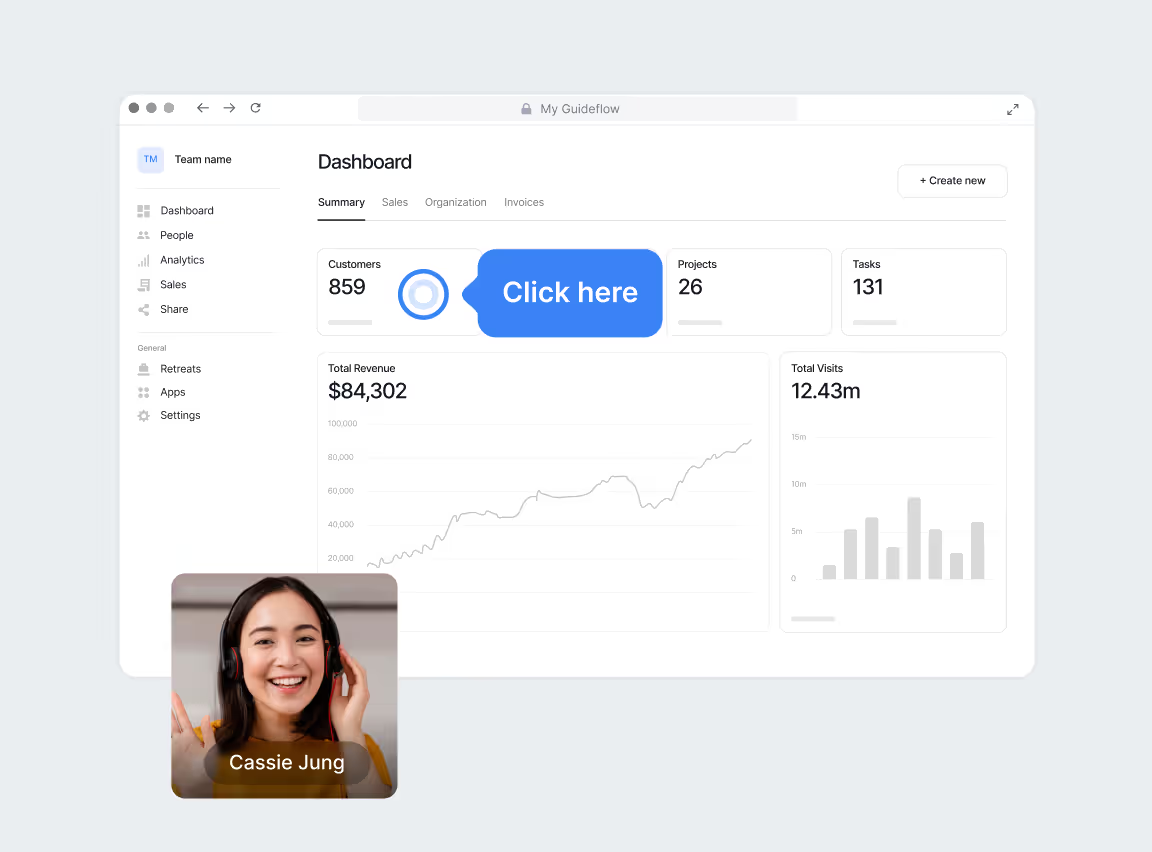
Challenge
Advanced product areas such as automation workflows, multi-step integrations, or admin settings may overwhelm users and internal teams when delivered through traditional docs or slide decks. Static content fails to convey nuance, leading to misunderstanding, misuse, or underuse.
Solution
Use interactive demos to break down complex workflows into guided, clickable experiences. Add contextual calls to action, visual cues, and just-in-time explanations to ensure users see what to do and understand why each step matters.
Check out the help site demo from SurferSEO that uses Guideflow to demonstrate how their Chrome extension works.
Benefits
- Turns intricate feature sets into intuitive, self-paced experiences
- Equips power users and admins to adopt confidently, without hand-holding
- Reduces training time for internal teams across Sales, CS, and Support
- Adds clarity and depth to existing documentation and onboarding materials
- Helps reinforce best practices through embedded, scenario-specific guidance
When to use
- In onboarding journeys for advanced or enterprise users
- Inside customer academies, webinars, or LMS courses
- Within support articles covering complex configurations
- As internal enablement tools for cross-functional teams
Think of it as your most sophisticated feature - explained without friction, confusion, or extra calls.
Use case 6: Collect better feedback during roadmap planning
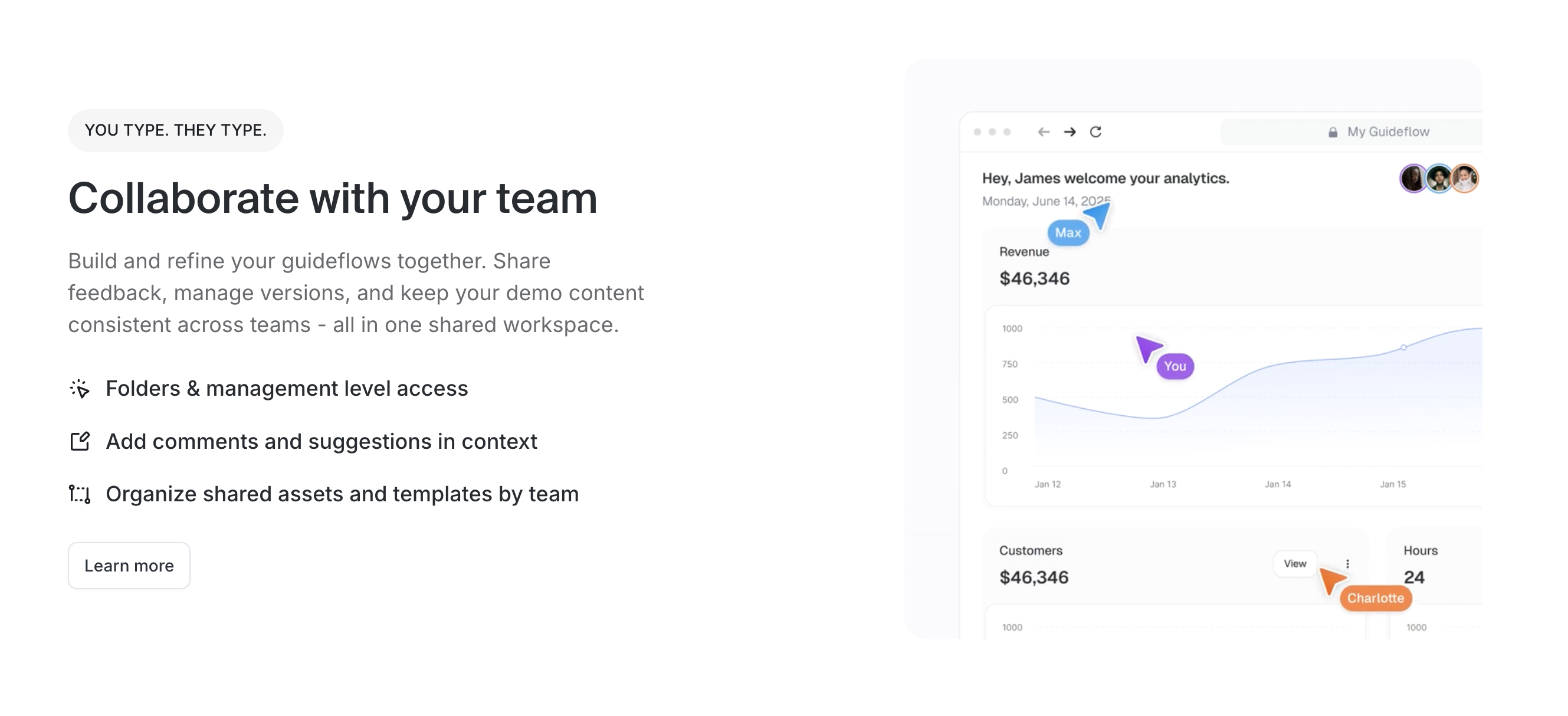
Challenge
Roadmap discussions often rely on abstract ideas, static decks, or verbal explanations, making it difficult for stakeholders to evaluate potential solutions clearly. This can lead to prioritization misfires, lukewarm alignment, and overlooked usability issues.
Solution
Use interactive concept demos to bring early feature ideas to life. Let internal and external stakeholders experience your proposed direction through a clickable flow. It grounds conversations in reality and surfaces meaningful, actionable feedback earlier in the product development cycle.
Benefits
- Transforms abstract concepts into tangible previews
- Uncovers edge cases and usability gaps before dev sprints begin
- Drives faster consensus across product, design, and GTM teams
- Builds trust with customers by showing, not just telling, what's next
- Turns roadmap reviews into active co-creation moments
When to use
- During product discovery or solution exploration phases
- To gather stakeholder input before finalizing PRDs or wireframes
- In roadmap reviews with execs, sales, CS, or customer councils
- As part of the alpha/beta program, previews or research interviews
Think of it as a clickable prototype with a purpose designed to validate what matters before you build.
Use case 7: Improve user testing

Challenge
Traditional usability testing often relies on abstract prototypes, slide decks, or observation notes, which can miss critical context and slow feedback loops. PMs struggle to capture how users truly experience a flow in motion.
Solution
Use interactive demos as part of usability testing and early access programs. Let users engage with clickable, guided experiences that mirror the final product. Embed feedback prompts at key moments to capture insights exactly where decisions happen.
Benefits
- Enables richer, task-oriented feedback rooted in interaction
- Surface usability issues earlier in the dev cycle
- Reduces ambiguity and speeds iteration with contextual input
- Provides test participants with more natural, self-directed exploration
- Aligns UX and product teams with genuine user sentiment
When to use
- During prototype testing and early concept validation
- In alpha or beta testing cohorts
- For structured research sessions or async testing
- As a follow-up to launch experiments or onboarding flows
Think of it as a guided usability lab available anywhere, anytime, and purpose-built for faster product refinement.
How to create interactive demos with Guideflow
Creating impactful interactive demos as a product manager isn’t just about showing how something works; it’s about validating ideas, aligning teams, and driving confident product decisions. Here’s how to do it with Guideflow:
1. Define your product objective
Is this demo helping validate a concept, gather feedback, onboard a team, or explain a complex feature? Anchor your walkthrough to a real product milestone like a roadmap review, launch, or sprint planning.
Tip: Tie the demo’s purpose to a product KPI or cross-functional goal like reducing feature adoption lag, speeding enablement, or validating beta interest.
2. Choose the right timing and audience
Context is everything. Are you testing a new idea with customers? Enabling Sales or CS before launch? Getting feedback from internal reviewers? Pick the moment in the product lifecycle and the personas that will benefit the most.
Pro move: Use Guideflow’s embed options to drop your demo into Slack threads, Notion docs, Jira tickets, or feedback surveys for seamless distribution.
3. Storyboard your flow like a mini prototype
Map the key steps of your feature or concept. Where does the value become clear? Where might users get stuck? Your goal isn’t to replicate the product; it’s to convey the experience. Keep the flow tight and focused. Start with the problem the feature solves, walk through the interaction, and end with a prompt or insight. This helps internal and external audiences quickly “get it.”
4. Build the walkthrough with product context
Record the live UI (or a working prototype) and annotate it with tooltips, modals, or side prompts that explain what’s happening and why. With Guideflow, you can easily layer in storytelling elements and optional branching.
Copy tip: Use natural, conversational tone to guide users. Assume they don’t know the feature because they often don’t.
5. Add structured feedback points
Want real validation? Embed polls, open-text feedback fields, or emoji reactions directly inside the walkthrough. This turns your demo into a testing loop, no extra tools required. Use feedback logic to route different user types down different paths, especially for role-based features or multi-persona UX.
6. Share with purpose and track results
Once your interactive demo is live, distribute it intentionally: use it in roadmap reviews, design crits, beta groups, or launch readiness meetings. Guideflow’s analytics help you understand where viewers drop off, what they click, and where clarity is lacking. Let product usage and feedback guide future iterations, not guesswork. Every view is a signal.
Conclusion
In 2025, product managers are expected to do more than ship features; they’re expected to align teams, validate ideas, drive adoption, and deliver measurable impact. Interactive demos meet this challenge head-on by transforming how product teams communicate, test, and scale their work. From pre-launch validation and stakeholder alignment to user onboarding and internal enablement, interactive demos are more than just a “nice to have.” They are a versatile, no-code layer of clarity that helps PMs move faster, reduce guesswork, and make smarter product decisions, with less dependency on engineering.
With tools like Guideflow, you’re not just showcasing your product; you’re telling a story users can feel, stakeholders can align behind, and teams can rally around. Start small, test often, share early, and let your product speak for itself, click by click.
→ Start your first product marketing demo today with Guideflow.
Related posts
Learn more about Guideflow, our approach to authentication, and company news.






